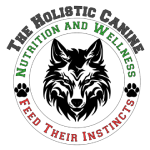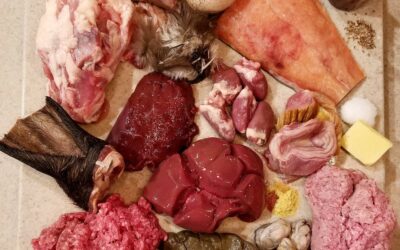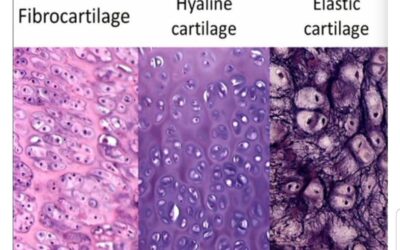From Commercial Dog Food to Raw
Switching to a homemade raw diet is one of the most daunting decisions a pet parent will ever make on behalf of their beloved canine. After all, veterinarians, the dog food industry, and organizations such as AAFCO and the NRC make canine nutrition out to be a very complicated, multifarious, intricate, obscure, alarmingly difficult, and better-left-to-the-experts business that no well-meaning pet parent would possibly dare to take into their own hands. I am sure nearly every raw feeder has at least at one point felt that wave of concern or fear when starting out on their homemade raw nutrition journey, and even years into their nutrition strategy. And for good reason! We all want what is best for our dogs, and we especially do not want any harm to come to them because of something we have done incorrectly. While I am certainly not about to sugar coat the decision to take your dog’s nutritional requirements into your own hands, I do, however, want to assure pet parents that it is not as scary and intimidating as you might think. Thousands of people have been raw feeding their dogs for decades, many of them breeders with upwards of five generations of strictly raw fed dogs. This has given us some invaluable insight into the positive changes in epigenetic gene expression as well as to learn what works and where problems can and do arise. If you have made the decision to transition to a DIY raw nutrition plan, you have some homework to do with the added help of numerous resources to assist you along your journey. (Don’t hesitate to join The Holistic Canine’s Facebook group for resources and support, or use us for a personal one-on-one experience to give you the confidence you need.)
Assuming you have already read my blog posts Feeding the Modern Canine and DIY Raw Dog Food (if you have not yet read through parts I through V as well as DIY Raw Dog Food, it is highly advisable that you begin by reading through everything as this is a necessary step to prevent harm from coming to your dog), and have read books such as Canine Nutrigenomics by Dr. Jean Dodds & Diana Laverdure, referred to other vital books and information from holistic raw feeding veterinarians such as Dr. Karen Becker, Dr. Peter Dobias, Dr. Ian Billinghurst, and Dr. Tom Lonsdale (among others), and scoured professional blogs such as Dana Scott’s Dogs Naturally Magazine, then you are prepared to start. You will notice that I am quite serious about my own nutrition and natural health practice and understanding, and even more, relaying this adequately to my clients for their practice and understanding as well. Nutrition must be in the correct context, especially for the modern canine. We call this orthomolecular nutrition. I do not recommend putting too much stock in some of the popular raw feeding websites, blogs, and Facebook groups that were started by well-meaning raw feeders who have minimal education from online certificate courses. While these courses are fantastic for the individual pet parent to receive a suitable foundation for providing their best to their beloved canines, it is not a sufficient education experience to be selling pet nutrition plans and recipes to other pet parents. I have heard enough horror stories to make even the hardest person cry. As a practitioner, I am held to the highest of responsibility when affecting another living being with my advice as well as to the people who love and care for them. I cannot stress this enough: persist with the holistic veterinarians and pet professionals who have been in this field for decades and have a plethora of results to show.
Having completed your research, the following checklist is a must to begin your raw food journey:
- You must have your dog’s specific nutrient requirements for protein, fats, minerals, and vitamins.
- You will need to know how much raw food to provide. Generally, we begin a raw food transition by offering 2.5% of your dog’s current body weight.
- You should have a nutrient-profile database to which you will be referring such as cronometer or the USDA database.
- It is helpful to have an auditing spreadsheet that will calculate the nutrients as you add ingredients. It is not, however, necessary if you are okay with doing some paper and pen calculations.
- You must also have a food scale. You cannot “wing it” especially when first beginning to create raw meals. I still rely on a food scale. I in no way want to eyeball my amounts especially when some nutrients are difficult to source in adequate amounts and others can become toxic in too high an amount. I do admittedly eyeball the bone content. After years of raw feeding, I am confident with adding my bone in varying amounts because it balances out over a couple of days. If you are feeding a puppy, you need to weigh the bone. A puppy’s skeleton is growing rapidly. You must maintain the correct calcium to phosphorous ratio in the required amounts for proper skeletal and joint formation.
- Be sure to take into consideration some important details about your dog. Does your dog…
- have food sensitivities?
- have a health condition?
- have age against them?
- gulp or bolt their food?
- need to lose body fat?
And lastly, some additional items to keep on hand if needed or required:
- probiotic and enzyme supplement(s)
- apple cider vinegar
- omega-3 source such as krill oil or phytoplankton
- Manuka honey
- Slippery Elm Bark
Final notes before you begin: Avoid offering foods to which your dog has sensitivities. Bear in mind that you will be feeding whole foods and bone. If you have a dog that does not currently chew their food or a senior dog that has difficulty chewing, you will need to consider the type and form of meat and bone that you will be offering. I am not one who recommends grinds (a small percentage is fine, but not entire meals). A dog is meant to chew on bones. The chewing action not only massages the gums and helps to maintain overall oral health, but also stimulates the trigeminal nerve acting as a pacifier by releasing hormones that stabilize mood. Your dog’s oral health is fundamental to creating and maintaining overall body health! Offer grinds only if your dog cannot physically chew. Patience is necessary for a gulper. It is highly recommended that you teach a gulper how to chew by holding the bone and correcting their action. And finally, transitioning to raw is not the time to reduce calories for body fat reduction. Wait until after your dog is fully transitioned and doing well on a raw diet.
If you are currently feeding a premade commercial raw food, you can transition to a DIY meal easily. Just follow the guideline in the DIY Raw Dog Food post. When you are confident with your meals, simply remove the commercial pre-made raw food from the diet completely.
For everyone else feeding a processed commercial kibble or canned food diet, transitioning is often the most difficult step. Many dogs are damaged from the processed foods and must heal their gut in order to digest raw foods without an issue. This is not to say that many of my clients have not had success with a “cold turkey” switch, because the truth is, they have. I am one of those who switched two adults and one puppy “cold turkey” without a single issue. You have to take into consideration your dog’s current health and current diet. If you are feeding a brand by Mars Petcare Inc., Nestlé Purina PetCare, Hill’s Pet Nutrition, Big Heart Pet Brands, or Spectrum Brands/United Pet Group, you should consider a gradual transition especially if your dog has been on these foods for three or more years and/or has minor health conditions such as digestive concerns, chronic ear infections, skin issues, joint issues, or any other condition. It is highly advised to start your dog on a probiotic, and possibly even an enzyme supplement, one week prior to the transition. You will continue to supplement throughout the process. This is especially important for dogs who have health conditions.
If you have a puppy that you would like to transition, you cannot do a gradual switch. You MUST do a cold turkey switch to a balanced raw diet because a puppy must have all their nutrients supplied in the required amounts on a daily basis. Switching to a balanced pre-made raw is my best advice for a beginner to raw feeding. Then you can gradually switch your growing pup over to a DIY raw food plan when you are confident that you can provide balanced meals.
Whether you switch your adult dog gradually or cold turkey to a raw food diet, you will want to begin with a single low-fat protein source. It is recommended to begin with chicken breast as it is easier to digest, but there is no rule or real reason why you must transition your dog with chicken. Some dogs do not tolerate chicken well. It is the lower-nutrient, more bland meats that we are going to use to transition. Read the ingredients on the bag or can or pouch of food you are currently feeding. Choosing a bland protein that your dog is already consuming in their current food is a good option. You want to make the transition as easy as possible. What is beneficial about offering chicken, however, is the ease of introducing bone. Chicken is by far the easiest bone sources for dogs just starting out on raw. Bone options include ribs, backs, necks, wings, feet, thigh bones, and drums. Choose what is appropriate to your dog’s size. Small bones for small dogs (wings, necks) and larger bones for big dogs (thighs, backs, drums). What I do not like about chicken, especially in a transition, is the high linoleic acid (omega-6 fatty acids) content. If your dog already has some gut issues, you will need to supply omega-3 fatty acids to prevent the delay of healing cellular and gut inflammation. Offer your dog krill oil or phytoplankton with chicken. Turkey is another introductory meat you may wish to opt for in place of chicken. Be aware that if you choose turkey, grocery store turkey often has broth added. Check the sodium content on the package. You will not want to feed turkey with a brine solution added. Dogs do require sodium, but we do not want to over-do sodium intake, especially during a transition to raw. Quail and Cornish hens are also good transition meats with equally easy bones to offer. And it you have access to domestic rabbit, rabbit is also a good starter protein along with bones to offer (ribs, neck/back bones, and feet are good bone options).
Bone will be required on day three. Use whole cuts of meat and avoid ground meat during the transition as grinds have an increased surface area which can equate to more bacteria. Following a week of poultry, adding red meat is a necessity. Grass-fed beef or bison are highly recommended as they are nutrient-dense and contain beneficial fats. Most of these meats are easily attainable from a grocery store, farmer’s market, and even Walmart. If you know your dog has protein sensitivities, avoid offering those proteins at least until your dog has been on raw for six months to a year with noticeable health improvements. Reintroducing a protein is not advisable unless under the direction of a nutritionist or holistic veterinarian well-versed in raw food and/or TCM food therapy.
Gradual Transition for an ADULT dog: Having chosen your low-fat transition protein and bone (and determined whether or not you will be adding a probiotic/enzyme supplement to their diet), you will begin by offering a “taste” of raw meat (without bone or skin) opposite meal time especially if your dog is kibble fed. If you feed one meal per day, the transition is very simple. Feed the raw meat in the morning or evening, whichever is opposite the meal. If you feed twice a day, feed the raw meat in-between the two meals. A “taste” can be approximately one half (½) ounce, one (1) ounce, or two (2) ounces of lean meat for a small to large dog while a toy dog will begin with a training-treat size piece. Choose the introductory amount proportional to your dog’s weight. Feeding the raw meat opposite mealtime will stimulate the stomach to lower the pH in the presence of the meat and thereby greatly reduce the possibility for pathogenic bacteria proliferation. Since raw meat is a protein, the stomach lowers the pH to create an acid bath to break apart the peptide bonds holding the amino acids together along with killing bacteria. Kibble is digested as a starch which raises pH and speeds up passage into the small intestine where bacteria could enter. While a carnivore has no issues consuming pathogenic bacteria, feeding raw meat with kibble increases the risk for bacteria produced diarrhea. If you have a dog with a digestive health condition, start by soaking the raw meat in diluted apple cider vinegar for at least 10 minutes to remove any pathogenic surface bacteria. (You may opt to follow the soak with rinsing the meat in cold water before feeding it.)
If your dog is accustomed to eating fresh vegetables and fruit, you may wish to continue to feed them as you did prior to the transition. If not, hold off until you are certain your dog’s system is doing well on the transition to raw. Introduce only small amounts of pureed vegetables and berries.
Beginning on day one, offer the raw meat (without bone and skin) to your dog on an empty stomach as per your chosen method listed above. If all goes well and your dog has no digestive upset or diarrhea (semi-formed/mushy stools is not uncommon, it is the liquid diarrhea you will be concerned with), repeat the same amount of meat the following day. If liquid diarrhea occurs, take a break until stools are solid and then start again. If all is fine, on day three, double the amount of meat and add in 20% of your chosen bone as well as some skin (if you used the apple cider vinegar method the first two days, you may stop on day three). Bone helps to keep the stools firm, thus adding 20% bone during the initial few days of the transition is beneficial. Continue feeding this same protein adding an additional half (½) ounce, one (1) ounce, two (2) ounce, or treat size (whichever amount you began with) while also adjusting the bone to 20% and eventually reducing it to 15% (see chart below). Begin proportionally reducing the commercial food until you have completed one full week. By the end of 7 days, you should be half commercial food and half raw meat. If you had been feeding only one commercial food meal per day, you are now feeding half the amount of commercial food at your dog’s usual mealtime, and you will have added a raw meal at the opposite time. If you were feeding two meals per day, you will be completely eliminating one of the commercial food meals so you are now feeding one commercial food meal and one raw meal at the opposite time. Bear in mind, you have now created an imbalanced diet. We will begin to slowly create balance and remove the commercial food completely.
The following chart is an example transition using one (1) ounce of meat for a medium size dog normally fed once per day. Adjust according to your specific needs/plan.
WEEK ONE
Day 1:
- AM: 1 oz. raw meat
- PM: Commercial food meal
Day 2:
- AM: 1 oz. raw meat
- PM: Commercial food meal
Day 3:
- AM: 2 oz. raw meat* + 20% bone
- PM: Commercial food meal
Day 4:
- AM: 3 oz. raw meat + 20% bone
- PM: Reduced commercial food
Day 5:
- AM: 4 oz. raw meat + 20% bone
- PM: Reduced commercial food
Day 6:
- AM: 5 oz. raw meat + 15% bone
- PM: Reduced commercial food
Day 7:
- AM: 6 oz. raw meat + 15% bone
- PM: Commercial food reduced to half fed**
*Begin gradually adding skin-on meat if feeding poultry.
**While dropping the kibble to half the total amount normally fed is likely less than the small amount of raw added, this is better to allow your dog’s body to adjust.
Beginning on day one of week two, if all went well in week one, adding a nutrient-dense red meat is advised. If your dog is already eating multiple protein sources in their commercial food, you can add an additional protein found in the current food. As noted above, I prefer grass-fed beef; however, bison or pasture-raised goat, pork, and lamb are also good choices. Offer the new protein the same way you introduced the first introductory protein. You are going to be adding this to the raw meal while you will work on removing the commercial food completely from the diet by the end of this week. Also notice the bone percentage will continue to drop. For simplicity sake, I will not list the commercial meal in the following chart. If you feel your dog needs an additional week with just the introductory meat, stay with that one single protein and continue to increase the amount daily as you did in week one.
WEEK TWO
Day 8: AM: 6 oz. meat one, 1 oz. new meat + 15% bone
Day 9: AM: 6 oz. meat one, 1 oz. new meat + 15% bone
Day 10: AM: 6 oz. meat one, 2 oz. new meat + 12% bone
Day 11: AM: 6 oz. meat one, 3 oz. new meat + 12% bone
Day 12: AM: 6 oz. meat one, 4 oz. new meat + 12% bone
Day 13: AM: 6 oz. meat one, 5 oz. new meat + 12% bone
Day 14: AM: 6 oz. meat one, 6 oz. new meat + 12% bone
If at any point your dog develops diarrhea, do not panic. Give your dog’s system a chance to adjust. Remove all visible fat and skin from the meat and increase bone back up to 15% to 20%. One day of diarrhea is not uncommon; however, if stools do not begin to firm by the end of day two, add a probiotic or double the amount you started with and bring the bone back up to 20% for a day or two. Give a dose of the probiotic at least 30 minutes prior to feeding the raw meal. Manuka honey is helpful as well. Give a dose according to the size of your dog from 1/2 tsp to 2 tsp. Slippery Elm Bark also ameliorates diarrhea. This can be given 15 to 20 minutes prior to the raw meal.
Depending upon the speed of the transition, week three or week four must include organs to further balance the diet. Organ meats are nutrient-saturated. The richness of these foods can cause loose stools and diarrhea. If you have already battled diarrhea during this transition, introduce organs SLOWLY. Start with liver. I prefer calf liver as a first introduction to secreting organs. Calf (and beef) liver is richer in copper than other livers and is cleaner than beef liver. You will only feed liver at 5% of the total diet if feeding daily. Add small amounts of liver each day until you are up to 5%. If the stools remain firm (you may notice darker stools, this is normal), introduce a second secreting organ such as kidney or spleen to be fed along with the liver. Beef kidney is easy to source. This too is fed at only 5% of the diet making secreting organs a combined total of approximately 10% of the daily meal(s). You will be feeding 10% to 15% bone this week.
By week four or week five, begin slowly introducing more proteins and muscle organs such as heart, gizzards, and lungs. These are fed as main protein sources at approximately 15% of the total diet. Gradually add in more vegetables, fruits, seeds, and other foods that will help increase nutrient-saturation within the meals. Your goal at this stage is to provide a balanced diet. Pay attention to stools as they are the key to how well your dog is digesting foods and either thriving or having difficulties adjusting fully.
Some dogs are what I call “lead bellies.” “Lead belly” dogs can eat anything and everything without a single issue. Even so, you don’t want to shock the system. These dogs do well with a “cold turkey” transition to raw. If you have a hardy dog prior to transitioning to raw, but a “cold turkey” switch sounds scary, you may opt to remove commercial food already after day seven. You know your dog best! Transition according to what is going to be the best option for both you and your dog.
And finally, be sure to start auditing your nutrients by either entering your meal ingredients in a spreadsheet calculator or by looking up nutrient profiles and recording your nutrient values in each meal. It will get easier as time goes by! Welcome to the world of raw feeding!
©2019 Kimberly Lloyd, PhD, BCHHP, Cert Raw Dog Food Nutritionist



